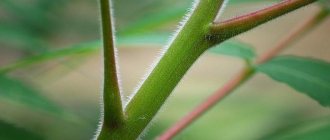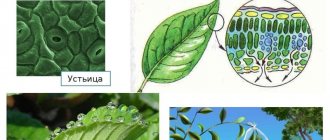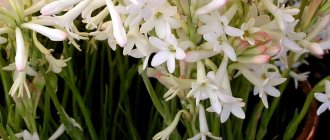To ensure that orchid care meets the requirements, you need to know how its green mass is structured.
Because this plant is epiphytic and a lot of nutrition comes to plant cells through the vegetative green mass .
Without knowing the structure of the green mass, you may not notice changes and not understand that the orchid is sick.
Plant life cycle
The life cycle of an orchid consists of two phases - growth and dormancy . The duration of these phases depends:
- from the orchid variety;
- from living conditions;
- from selected care.
The better the care, the better the orchid will develop and grow.
After the new shoot has fully developed, the plant goes into dormancy, here growth buds appear, in some cases, flower buds may even appear. After this process is completely completed, the plant again enters the growth phase.
The life cycle of a plant directly depends on the condition of the leaves, as they play an important role in metabolism.
The water-salt balance depends on them, they also help moisture evaporate and receive nutrients and minerals from the soil. In addition, without leaves, photosynthesis and plant respiration could not be possible.
The Importance of Foliage
Most representatives of the Orchidaceae genus, which are grown on windowsills, belong to the epiphytic class. These are plants that live on trees or other plants, using them as support. However, they are not parasites.
Foliage is of great importance for epiphytes. Not only thanks to rhizomes, but also leaf blades, orchids maintain water balance , receive nutrients, and evaporate moisture (you can learn about how an orchid, with the help of aerial roots, receives and stores moisture and sunlight here). Leaves also play an active role in the process of photosynthesis respiration.
Many changes in the structure of the flower are associated with adaptation to the negative factors of the wild environment. Also, the dense, fleshy tissue of the leaves serves as a kind of reservoir for the accumulation of life-giving moisture and micronutrients.
On a note. The flower absorbs the required amount of substances, thus, during the dormant period, it can survive in the difficult conditions of the epiphytic lifestyle.
Photo
In the following photo you can see what the foliage of the plant looks like:
Variegation of orchid leaves
Variegated orchids are valued not only for their flowering, but also for the beauty of their leaves. While the orchid has bloomed, you can admire the unique pattern of the tops.
Variegation depends on the combination of different pigments in the cells; it can be more pronounced on young leaves under intense lighting. This color protects against burns.
Variability occurs for the following reasons:
- from natural mutation;
- in the process of artificial hybridization;
- due to the presence of genetically different types of cells in the same plant.
Pigmentation in cells may decrease in subsequent generations or remain completely. Depends on the type of cells.
Types of leaf variegation
The type of variegation depends on the type of pigmentation and its placement on the leaf.
1. Red or purple variegation
Red or purple variegation is not the result of a cell defect. The green pigment chlorophyll, which is involved in photosynthesis, is present, but is masked by carotenoids or anthocyanins. These same substances can give yellow and ocher colors.
The orchid copes well with the functions of photosynthesis; the chloroplasts are not damaged, but are protected from the aggressive environment with the help of pigments - carotenoids and/or anthocyanins.
IMPORTANT! Leaves with red or purple variegation are more sensitive to the damaging effects of direct sunlight. That's why nature protects them with pigments. Such leaves easily and quickly get sunburned.
Natural, natural red variegation is inherent in some phalaenopsis - Schiller, Stewart and others, as well as interspecific hybrids with their participation.
Phalaenopsis Schiller
The leaves of these species of phalaenopsis have specks , sometimes merging into transverse stripes.
Variegation in these phalaenopsis is more pronounced in more intense lighting and on young leaves (leaf color is simply protection of delicate leaves from the sun).
Many species and interspecific hybrids of Paphiopedilum have red (brown) and purple variegation.
2. Yellow and white variegation
Yellow and white variegation is the result of a defect or absence of chloroplasts, that is, plastids that contain chlorophyll. If the chloroplasts are damaged yellow variegation appears ; if there are no chloroplasts at all the leaf or part of it will turn white
Yellow and white variegation is a deviation from the norm; such orchids are weakened compared to their green relatives.
Types of variegation
1. Media variegation (central) – red, yellow or white. The color of the leaf changes in the center of the leaf.
2. Marginate (bordered) variegation - yellow or white coloring is located along the edges of the leaf.
3. Splash (uneven) variegation - yellow or white color is located randomly across the leaf, often in longitudinal stripes. Red or purple splash variegation occurs in Phalaenopsis and Paphiopedilum.
The brightness of the variegation depends:
- temperature conditions (at high temperatures, brightness increases);
- in bright light, the color of the leaves intensifies, since such species are more sensitive to light;
- during the period of active growth of young leaves, pigmentation increases;
- when using fertilizers with a high nitrogen content, the pigmentation is not so bright;
- with increased moisture-lovingness of the orchid in a dry climate, variegation may not appear or have weak signs, barely noticeable.
Features of keeping variegated orchids
Variegated orchids are more demanding in terms of living conditions. That is, leaf spotting may go away with age or is lost, and in bright rays the leaves are more susceptible to burns.
The only available tools to influence the brightness and severity of variegated areas:
- lighting level (diffused light 10-30 lux),
- temperature (20-25 degrees),
- air humidity (40-70%).
We cannot influence the quantity and quality of variegated segments in any way; it is impossible to control the appearance and activation of variegation in orchids at home.
What color is not normal?
The color of orchid leaves is green, the shade depends on the variety and living conditions of the plant, but green is always a healthy color.
- Yellowing indicates that the plant is withering or drying out; this may be due to improper care. Also, too much fertilizer can cause yellowing of the leaves.
- Purple spots indicate that the orchid has been exposed to the sun for a long time and has received a sunburn.
- A red tint indicates that there is excessive lighting in the room.
- A brown color is a sure sign that the plant is infected with a disease.
- White or discolored areas with a brown outline indicate sunburn.
- Light areas that then begin to turn red may indicate the presence of a disease such as rust.
- Yellow rings and spots can indicate the presence of a viral disease.
Frostbite
Drafts and low temperatures can lead to freezing. In this case, the leaves will curl into a rag. To prevent rot from developing, frostbitten areas are cut off.
The structure of an orchid is different from most other flowers. Read about the pseudobulb, growing point, arrow or peduncle, dormant buds, children and aerial roots of the plant.
The foliage of a healthy orchid is shiny green with a waxy coating without spots or damage. Any deviation from this description is evidence that the plant is not comfortable or is completely affected by the disease.
What is the leaf arrangement?
The leaf arrangement of orchids can be different, it depends on the variety and living conditions, but most often there is a two-row or alternate leaf arrangement. Sometimes a change in leaf arrangement may indicate a plant disease .
The structure of the sheets and their location on the sunny side may differ from the location on the shady side.
Leaves growing on the sunny side are more elastic and dense, this is due to the fact that they need to withstand direct sunlight.
Structure
Do orchids have simple or complex leaves and what is their leaf arrangement? The leaves of the plant are mostly entire and entire outermost, namely on the sides, usually parallel-nervous and without a noticeable petiole. The leaf blade of orchids is simple, with arched venation.
Reference. The predominant number of epiphytic relatives have articulated leaves and can be shed. In other subspecies of the Orchid family, they do not have articulation, as a result of which they do not fall off, but dry out or rot together with the stem.
Basically, orchids have a two-row, alternate leaf arrangement.
Proper care
- Wipe the leaves regularly with a damp cloth.
- Normal air humidity for an orchid is 60-70%, but in an apartment it is much lower, so you need to spray the plant 3-4 times a week, this is especially important if your air conditioner is constantly running at home, it dries out the air very much.
- You need to water the orchid once a week in summer, and once a month in winter. The water should be clean with a temperature of 35 degrees.
- The plant should be on the shady side of the room. But it still needs light; a 40 W lamp will be enough for the orchid, but it needs to be installed so that the leaves and inflorescences get enough light.
- Inspect the plant for insects or color spots.
- When the room is ventilated, it is necessary to move the plant to another room, since the plant does not like sudden changes in temperature.
- The orchid also needs mineral fertilizers that contain phosphorus, nitrogen and iron.
Functions of leaves
In sympodial orchids, nutrients accumulate in bulbs (pseudobulbs), and for monopodial species, this role is played by leaves.
Functions of orchid leaves:
- photosynthesis;
- evaporation of water (transpiration);
- gas exchange;
- accumulation of nutrients.
The growth of leaves is limited to a certain size, unlike the roots and the stem itself.
The lifespan of leaves is different for each species. On average, leaves change from one to three per year. The old ones begin to turn yellow from the edges and gradually fade and dry out.
The dying process takes from one to several months.
Diseases
Rot
Many diseases lead to a complete or partial change in the color of the leaves; at first they may acquire a reddish color, and then completely turn black. This indicates the presence of rot. To get rid of this disease, you need to carefully remove the affected areas.
Anthracnose
If you notice clear brown spots on the leaves of your plant, it could be Anthracnose. This disease can appear due to high humidity; areas with stains must be removed and the sections treated with charcoal .
Powdery mildew
Small fuzzy white spots can indicate the presence of a disease such as powdery mildew. If this disease is not treated, the plant may die. The cause of this disease can be high humidity and hot temperatures. This disease can be treated with a drug such as Skor or Topsin.
An orchid is an exotic plant that requires special care. By its leaves you can understand the general condition; if they are dense and pale green in color, then the plant is healthy. And if they change color or spots appear on them, this indicates the presence of a disease.
Color
A healthy leaf is strong, dense, firmly attached to the stem, and has a green color. Despite this, a fairly large proportion of Orchids have variegated colors. Certain species are grown solely for the decorative features of their foliage , while at the same time the inflorescences are inconspicuous.
Such representatives include: anectochilus, gemaria, macodes. They are also called "precious orchids". Among the phalaenopsis and paphiopedilum, distinguished by the beauty of their flowers, specimens were noticed that can also be classified as decorative deciduous subspecies.
Questions to ask
Before you start torturing a plant with “correct” (from your point of view) care, you need to find out its needs. Fortunately, the abundance of information on care and maintenance will help you avoid basic mistakes and subsequent “reanimation” of the plant. To do this, leave the orchid alone for a couple of days, ask yourself 3 simple questions and try to find answers to them.
Question 1. What is the name of the orchid?
The name of the orchid is one of the most important answers a beginner will have to find. Orchids are the largest family, representatives of which are found on all continents and in almost all climatic zones, with the exception of Antarctica. Naturally, the conditions of keeping different species are very different.
If there is a tag, it is very easy to determine the species of the plant. If the tag is missing, you should use numerous catalogs, reference books, illustrated atlases and Internet resources, which will certainly help you find the answer to the first question, because most stores do not shine with species diversity. Most often in retail sales you can buy phalaenopsis, dendrobiums, lady's slippers (paphiopedilum), cymbidiums, miltonias, vandas and cambrians.
Phalaenopsis, photo by Irina Zolotykh
Question 2. Where does it grow and how does it grow?
Do not rush to take active action, even if you find out the name of your orchid, especially if you have received a species plant, which also often happens. Try to find information about the places where the species grows: climate (temperate, subtropical, tropical), amount of precipitation, seasonal characteristics (presence or absence of a dormant period). You should also find out how the orchid grows - epiphytically or on the ground. The optimal planting method and the correct choice of substrate depend on this.
Orchids growing epiphytically
Terrestrial orchids
Question 3. How does an orchid work?
Carefully examine the plant, find out the type of growth (monopodial or sympodial). Monopodial orchids have one growth point, while sympodial orchids form new growths from the base each time. Pay attention to what healthy leaves, pseudobulbs (if any), or roots should look like.
Monopodial growth type
Sympodial growth type
If you managed to find the answers to the questions posed, then you will definitely be able to not only preserve and successfully grow the plant, but make it bloom.
Covering and watering
Cover the surface of the substrate with a layer of moss and do not water it for 2 weeks after planting, but only spray the lower surface of the leaves.
In general, I usually only spray the moss. Within 2 weeks after transplantation, the plant has time to recover and heal the broken roots. If there was rot somewhere, it dries out. In general, plants need these two weeks.
Unfortunately, it also happens that you dried the phalaenopsis, danced around it with a tambourine, but it still died.











